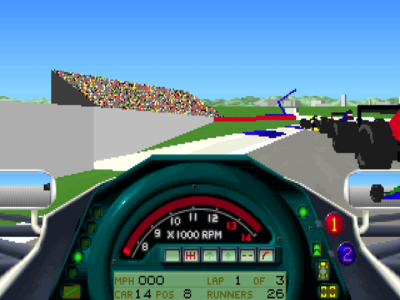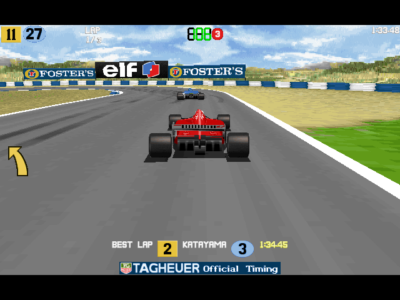The Vault of Regret is a very large place, which houses dusty old game CDs and boxes, untouched digital libraries, and the metaphysical concepts of remorse and embarrassment. Here we write about all the games we should have played but haven’t, or that we have played but didn’t enjoy, among other things.
Declaring an interest in Formula 1 seems like the ultimate way to advertise your advancing middle age. For those in the UK of a certain generation, a Grand Prix would often just be something that would happen to dominate one of the four terrestrial television channels on a Sunday, whether you liked it or not, and if you had even a passing interest, you would end up watching some or all of it.
Inevitably, it would later become the sole preserve of subscription-based sports channels, and hence only for people who actively wanted to pay money to watch it. At which point, the casual viewer largely disappeared, unless he or she was sufficiently interested in other sports to have those channels anyway.
However, the recent arrival of Drive to Survive on Netflix – also a subscription service, admittedly, although one with a broader range and viewer base – has recaptured that audience. Despite attracting the ire of more hardcore fans with its approach, it somehow manages to take the tale of three fairly unexciting F1 seasons, all of which were won by the same driver, and make them interesting, by focusing on individual and team stories from up and down the grid.
As a fan of driving games, this renewed interest did of course lead to thoughts of seeing what Formula One games – both old and new – might be worth a try.
In 20 years, we’ve managed a single review of an F1 game – the PC port of Formula 1 ’97, which was initially released, and found success on, the PlayStation. As acknowledged in that dusty write-up, despite a few idiosyncrasies, in terms of looking and sounding like the real thing while also being accessible enough to pick up and play, it pretty much nailed it. It was also the last F1 game to be developed by the now-defunct Bizarre Creations, who went on to create the marvellous Project Gotham Racing series on Xbox, which, as your correspondent has belatedly discovered, also hits a sweet spot at the arcade-y end of simulation rather successfully.
But F1 is a technical sport, with all of the off-track tweaking, performance and strategy almost as much a part of success as the driver behind the wheel, which means that most games have tended to lean in that direction. A key early reference point, particularly on PC, would be Formula One Grand Prix from MicroProse, which, along with two further sequels, dominated the 90s.
Our family had the first one on Atari ST, and my memory is of an intimidating challenge, akin to a flight sim, with a slightly droopy frame rate. Whenever I played, I was struck by an overwhelming sense that without most of the driving aids switched on I would never get around the circuit. I think I did try a handful of races with maximum assistance, which included automatic braking, but that just made me feel like I was actually doing very little driving myself.
By the time of Grand Prix 2, the PlayStation had arrived, and Bizarre Creations’ initial Formula One game had casual fans of F1 with a PC glancing over at the world of the small grey box with some degree of envy. Like the later follow-up, it would eventually be ported to PC, but in the meantime I was experimenting with inferior knock-offs, such as Power F1, a little-remembered, middling effort that pitched itself as an accessible alternative to the heavyweight sims. Nevertheless, it was still a bit of a pig to drive. I recall punctures occurring with such regularity that they seemed inevitable, with each race becoming a matter of waiting for a wheel to fall off altogether and end your chances.
The end of the decade brought Electronic Arts into the equation, although uncharacteristically for them this did not lead to their financial might slowly strangling and eliminating all competition until they obtained a monopoly on games based on a particular sport. Instead, they released a few moderately successful titles over a few years, before the exclusive rights passed over to Sony, which meant that their PlayStation consoles (2 and 3) were the only places you could find officially-licensed F1 action in the mid-00s.
In theory, the Sony games were a continuation of the earlier series from the original PSOne, although it had experienced mixed fortunes since the departure of Bizarre Creations in the 90s. It was at this point I dabbled with the 2003 or 2004 edition for PS2, but I again found it both too difficult (playing properly) or too forgiving (with aids and ‘stupid mode’ turned on). The challenge was – is – really to make it easy enough for someone to get around the circuit while still making them feel like they’re actually doing something.
Maybe the truth is actually that for it to feel good you really do need to practice the tracks and take the races one at a time instead of trying to breeze through like you would in a more arcade-y track-based racer, like TOCA Race Driver or NFS: SHIFT. Also, in those games, it feels perfectly ok to pause and restart when you mess up. But F1 is a sport, and you wouldn’t usually quit out of another sports game just because you were losing. And, arguably, there’s even more incentive for doing so here: having practiced the circuit and qualified well, it must be infuriating for real-life drivers to have their race, and their chances, ended prematurely due to a careless prang or technical issue.
In the last decade, Codemasters have become the stewards of officially-licensed F1 games, bringing the sport back to the PC, as well as consoles. They have a pretty decent track record with arcade/sim hybrid racers, from TOCA/Race Driver/GRID to Colin McRae/DIRT/DIRT Rally, and I have a couple of their older titles in the backlog from some bundle or other, so maybe it’s time to give it all another go.
Still, it’s likely that for the franchise to have succeeded and lasted as long as it has, the tastes of the hardcore petrolheads and fans need to have been adequately catered for. And it sure still looks like a lot of hard work. Is it too much to ask for a game in which there are no nuances, except that Mercedes and Red Bull have the fastest cars and Haas the slowest? Probably, yes.
Perhaps I will dabble again. Or go back to the older sims, and see what I can make of them. But until then, it’s probably best to submit Formula One games for storage in the Vault of Regret.





 Posts
Posts